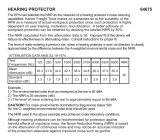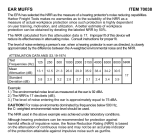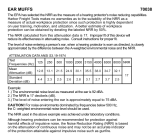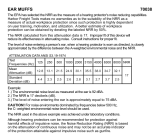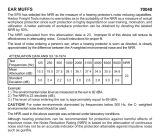Page is loading ...

EAR PLUGS ITEM 96365
The EPA has selected the NRR as the measure of a hearing protector’s noise reducing capabilities.
Harbor Freight Tools makes no warranties as to the suitability of the NRR as a measure of actual
workplace protection since such protection is highly dependent on user training, motivation, and
utilization. A better estimate of workplace protection can be obtained by derating the labeled
NRR by 50%.
The NRR calculated from this attenuation data is 29. Improper fit of this device will reduce its
effectiveness in attenuating noise. Consult instructions for proper fit.
The level of noise entering a person’s ear, when a hearing protector is worn as directed, is closely
approximated by the difference between the A-weighted environmental noise and the NRR.
ATTENUATION DATA ANSI S3.19-1974
Test
Frequencies (Hz)
125 250 500 1000 2000 4000 8000
NRR (without
40CFR211 correction)
Corrected
NRR
Mean
Attenuation (dB)
38.1 37.9 39.6 37.7 37.3 48.4 45.9
32 29
Standard
Deviation (dB)
4.9 6.3 6.5 4.2 3.5 5.1 4.5
Example:
1.) The environmental noise level as measured at the ear is 92 dBA.
2.) The NRR is 29 decibels (dB).
3.) The level of noise entering the ear is approximately equal to 63 dBA.
CAUTION! For noise environments dominated by frequencies below 500 Hz, the C- weighted
environmental noise level should be used.
The NRR used in the above example was achieved under laboratory conditions.
Although hearing protectors can be recommended for protection against harmful effects of
impulsive noise, the Noise Reduction Rating (NRR) is based on the attenuation of continuous
noise and may not be an accurate indicator of the protection attainable against impulsive noise
such as gunfire.

Wear Instructions
Make certain that your hands and the earplugs are clean.
Starting with light pressure, roll the first earplug back-and-forth
between your thumb and forefinger into a cylinder shape. Roll
it as tightly as possible. There should be no creases or folds
in the earplug.
Once the plug is rolled, insert it into the ear canal. You should
pull on your outer ear with one hand while you insert the plug
with the other. Insert the plug into the ear canal until it is flush
with the side of your head.
If the earplug is uncomfortable, wait 30 seconds for the fit
to improve. The earplug will shorten as it expands. If it is
still uncomfortable, pull it out slightly, or remove, re-roll, and
reinsert it.
Repeat the above steps for the remaining plug.
After both earplugs are inserted and are allowed to expand into
place, place cupped hands over both ears and compare the
sound level. With properly fitted earplugs, you should detect
little or no difference in sound level. If the one or both plugs are
not fitted properly, remove, re-roll, and reinsert the plug(s).
1.
2.
3.
4.
5.
6.
/

